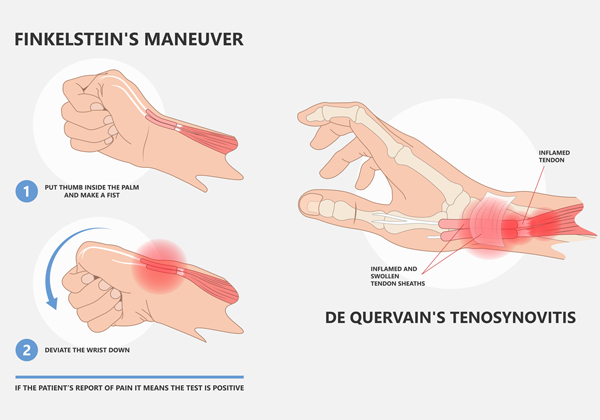Understanding De Quervain’s Tenosynovitis: Causes, Symptoms, and Treatment
An Overview
Do you experience pain and swelling at the base of your thumb, especially when gripping or pinching? You might have De Quervain’s tenosynovitis, a common condition affecting the tendons on the thumb side of your wrist.
What is De Quervain’s Tenosynovitis?
Imagine your thumb muscles are connected to your bones by two “cords” called tendons. These tendons glide smoothly through a tunnel in your wrist, allowing you to move your thumb. De Quervain’s tenosynovitis occurs when the sheath surrounding these tendons becomes inflamed and thickened, causing swelling and pain with thumb and wrist movements.
What causes it?
The main culprit is repetitive thumb movements, often referred to as a repetitive strain injury (RSI). This can happen from various activities, including:
- Gripping and pinching motions
- Wringing objects
- Frequent forceful use of the thumb, like lifting a child
Other factors can also contribute, such as:
- Pregnancy: Hormonal changes can make the tendon sheath more susceptible to inflammation.
- Medical conditions: Diabetes, rheumatoid arthritis, and osteoarthritis can increase the risk.
- Previous injury: Trauma to the wrist or thumb can scar and restrict tendon movement.
Symptoms
- Pain and tenderness: Mainly felt at the base of the thumb, worsening with gripping or pinching.
- Swelling: Noticeable bump on the thumb side of your wrist.
- Difficulty moving the thumb and wrist: You might experience a “sticking” or “catching” sensation.
- Pain spreading: In severe cases, pain can radiate into your thumb, back of the hand, and forearm.
Diagnosis
Your doctor will likely perform a physical examination, including a test called the Finkelstein test. This involves bending your wrist towards your pinky finger while holding your thumb in a specific position. If you have De Quervain’s, you’ll likely experience pain at the base of your thumb.
Treatment
Most cases of De Quervain’s tenosynovitis improve with non-surgical methods:
- Rest: Avoiding activities that aggravate the pain.
- Splinting: Wearing a splint to immobilize the thumb and wrist, allowing the inflammation to subside.
- Ice therapy: Applying ice packs to the affected area to reduce swelling and pain.
- Anti-inflammatory medication: Over-the-counter pain relievers can help manage pain and inflammation.
- Physical therapy: Exercises to improve flexibility and strengthen the muscles around the thumb.
If these methods don’t prove effective, your doctor might consider:
- Cortisone injection: Injections of a powerful anti-inflammatory medication to reduce pain and inflammation.
- Surgery: In rare cases, surgery might be necessary to create more space for the tendons in the tunnel.
Remember
Early diagnosis and treatment are crucial for a complete recovery and preventing long-term complications. If you experience persistent thumb pain and swelling, consult your doctor to discuss the best treatment option for you.

